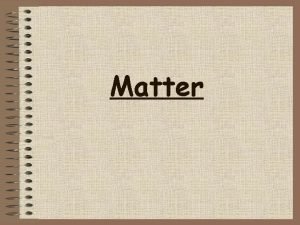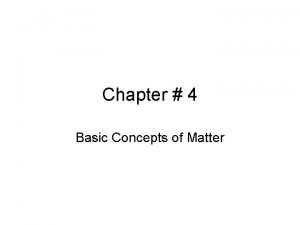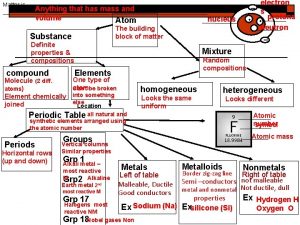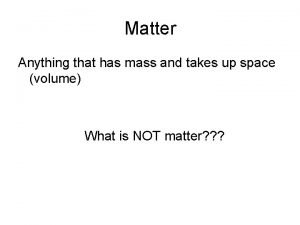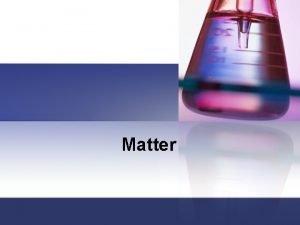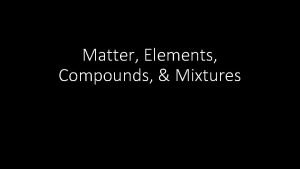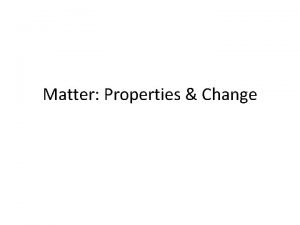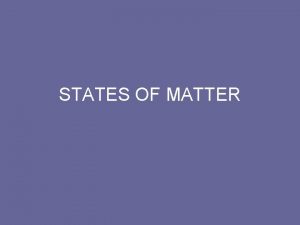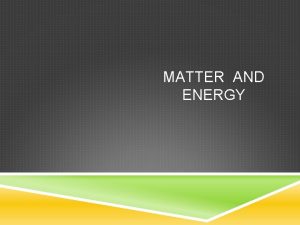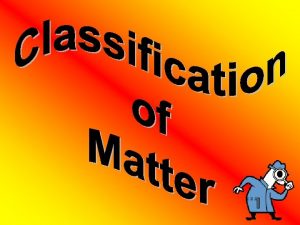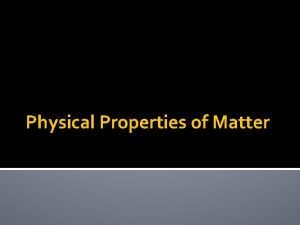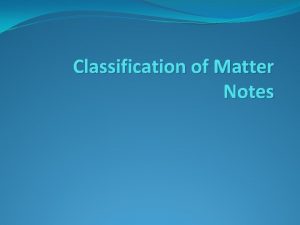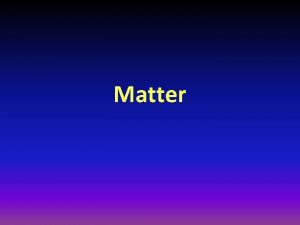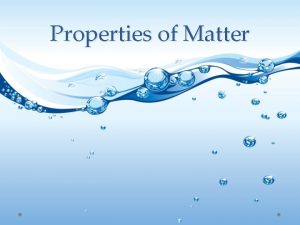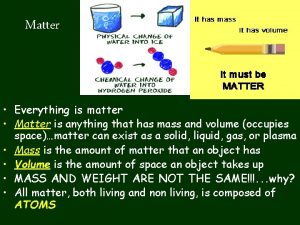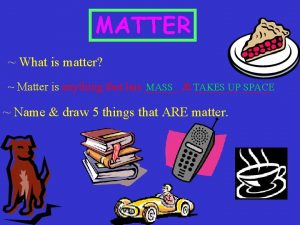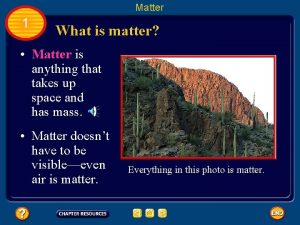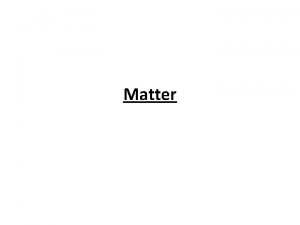MATTER Chapter 2 1 Matter Matter anything that


















- Slides: 18

MATTER Chapter 2 1

Matter • Matter: anything that has mass and takes up space (this includes air and gases) • Chemistry: the study of matter • Elements, compounds and mixtures • Matter can be classified as a pure substance or a mixture 2

Pure Substances • Pure Substance: matter that has a fixed composition (make-up) and definite (unchanging) properties • Examples include elements and compounds 3

Elements • Atoms: smallest unit of an element • Elements: substances that cannot be broken down into simpler substances by ANY chemical means! • Made entirely of the same atom! 4

Elements • Elements are represented by a 1 -2 letter symbol • 1 st Letter: always capital • 2 nd Letter (if present): lower case • C = Carbon • He = Helium • Capitalization is VERY important when writing the symbol for an element CO = carbon monoxide Co = cobalt 5

Compound • Compound: TWO different elements chemically bonded • H 2 O = Hydrogen & Oxygen • Molecule: smallest unit of a compound • Compounds can be broken down into other things 6

Compound • Compounds and molecules are represented by a chemical formula – symbols of the elements in them, and a subscript • Subscript: shows quantity of that atom in the molecule • If there is no subscript number then 1 is implied, but you don’t write 1! 7

Mixtures • Mixture: Compounds and/or elements mixed together but not bonded together. • Substances that make up a mixture keep most of their own properties • Mixtures can be separated by physical means • Iron and aluminum could be separated with a magnet, coffee grounds and water can be separated with a filter 8

Mixtures • Heterogeneous: different throughout or chunky, separation can be seen • granite, orange juice with pulp, Italian dressing • Homogeneous: the same throughout, no separation can be seen • metal alloys, air around you, milk and saltwater 9

Property • Property: attribute, quality, or characteristic • Properties of matter can be chemical or physical 10

Physical Properties • Any property that can be tested without changing the identity of the substance. • mass, weight, density, volume, color, shape, texture, melting point, and boiling point. • Helps determine the use of the substance • Aluminum is used in foil because it is lightweight, but durable and flexible • Physical properties can be used to separate mixtures, but CANNOT be used to separate a compound 11

Density • Density: ratio of mass to volume of an object. • D = m / v (density = mass / volume) • Physical property measured in g/m. L (grams per milliliter), OR g/cm 3 (grams per centimeters cubed) • Density of a pure compound or element is a CONSTANT (it never changes) • Pure water is always 1. 0 g/m. L 12

Density • Less dense objects float in more dense objects. 13

Chemical Properties • Any property that can only be tested by changing the chemical make-up of the substance. • Flammability, chemical reactivity, and ability to rust. • Can be used to separate mixtures and SOME compounds 14

Physical Changes • Affects physical properties without changing the identity of the substance • Melting, cutting, crushing • A physical property of aluminum is flexibility. If I bend a piece of aluminum, it has gone through a physical change, the identity of the aluminum has not changed 15

Chemical Changes • Happens when one or more substances are changed into entirely new substances with different properties • Evidence of a chemical change • bubbling, light, heat, color changes, an odor or a sound 16

Chemical Changes • You can tell a chemical reaction has occurred if the products are different from the reactants! • If there is no change it is NOT a reaction! • ice melting is NOT a reaction, it is a physical change! 17

Physical or Chemical Change? • cutting a piece of ice in half • physical change • activating an instant ice pack (make it cold) • chemical change • melting ice • physical change • baking flour, sugar, egg and water together • chemical change 18
 Ngoại tâm thu thất chùm đôi
Ngoại tâm thu thất chùm đôi Block nhĩ thất độ 1
Block nhĩ thất độ 1 Thể thơ truyền thống
Thể thơ truyền thống Thơ thất ngôn tứ tuyệt đường luật
Thơ thất ngôn tứ tuyệt đường luật Chiến lược kinh doanh quốc tế của walmart
Chiến lược kinh doanh quốc tế của walmart Tìm vết của mặt phẳng
Tìm vết của mặt phẳng Hãy nói thật ít để làm được nhiều
Hãy nói thật ít để làm được nhiều Tôn thất thuyết là ai
Tôn thất thuyết là ai Gây tê cơ vuông thắt lưng
Gây tê cơ vuông thắt lưng Sau thất bại ở hồ điển triệt
Sau thất bại ở hồ điển triệt Anything that has mass and take up space
Anything that has mass and take up space Anything that has mass and takes up space
Anything that has mass and takes up space Anything that has mass and takes up space
Anything that has mass and takes up space Name the entity that occupies space and has mass
Name the entity that occupies space and has mass Matter is defined as anything that
Matter is defined as anything that Matter is anything that has mass and volume.
Matter is anything that has mass and volume. Matter anything that takes up space
Matter anything that takes up space Anything that has mass and takes up space
Anything that has mass and takes up space Matter is anything that...
Matter is anything that...











